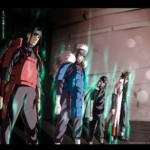In the vast world of Naruto, the Reanimation Jutsu offered a chance to resurrect deceased warriors at the peak of their powers. Among these legendary figures stood Nagato, known as Pain, revered for his mastery of the Rinnegan. However, upon his revival through the Reanimation Jutsu, Nagato exhibited unexpected weaknesses compared to his resurrected counterparts. Investigating the fundamental reasons for this reveals surprising aspects.

Understanding Reanimation Jutsu and Nagato’s Revival:
The Reanimation Jutsu revives individuals in the state they were in at the time of death. Nagato had already been weakened by the Outer Path: Samsara of Heavenly Life Technique, which had depleted his life and chakra. Consequently, his revived form lacked the strength of those who died without exhausting their abilities.
Factors Contributing to Nagato’s Relative Weakness:
Several factors contribute to Nagato’s diminished strength compared to other revived shinobi:
Physical Condition and Chakra Reserves:
Nagato’s weakened state at the time of death affected his revived form. Other revived shinobi, having died without such depletion, showed greater strength upon revival.
Mastery over the Rinnegan:
Nagato’s exceptional command over the Rinnegan was compromised in his revived state. This hindered his combat effectiveness, unlike other revived shinobi who retained their mastery due to less depletion before death.
Mental State:
The Reanimation Jutsu alters emotions and mindsets. Nagato’s inner turmoil might have impacted his combat abilities, unlike some others who maintained mental clarity.
Adaptation Period:
Revived Shinobi required time to readjust. Nagato’s lack of time to adapt may have affected his combat finesse.
Conclusion:
Nagato’s apparent weakness among revived Shinobi originated from his exhausted state at death, limited abilities in his revived form, mental struggles, and inadequate time to adapt. These factors created an unexpected power gap, despite his renowned skills.
Q-1: What is the Edo Tensei?

The Edo Tensei, also known as the Reanimation Jutsu, is a forbidden technique in the Naruto series. It was first introduced during Orochimaru’s attack on Konoha and was later used extensively during the Fourth Shinobi World War.
Q-2: How Does Edo Tensei Work?
1. Summoning: Edo Tensei is essentially a summoning jutsu that binds the soul of a deceased person to a living vessel, restoring the individual in the form they were before they died.
2. DNA Requirement: To make it work, the user needs to acquire some DNA of the person they want to reincarnate.
3. Soul Requirement: For them to reincarnate, the person’s soul needs to reside in the Pure Land; a soul that is trapped in the stomach of the Shinigami cannot be reincarnated.
4. Living Sacrifice: There needs to be a living sacrifice or a vessel for a reincarnated soul to attach to.
5. Special Scroll: Ultimately, the DNA needs to be smeared across a special scroll, formed in a special seal with the living person in the middle of it for the jutsu to work.
The reanimated shinobi has access to unlimited chakra, can regenerate from any attack, and all of their previous powers (even powers that aren’t theirs) are accessible. For example, when Kabuto reanimates Nagato, he even has his Rinnegan, which are Madara’s.
Q-3: who created Reanimation Jutsu?
The Edo Tensei was originally created by Tobirama Senju, the second Hokage of Konoha. However, it was Kabuto who finally perfected the jutsu into what it was in the Fourth Shinobi World War.


1 thought on ““Unveiling the Mystery: Why Nagato Was Weaker Than Other Revived Shinobi Explained!””